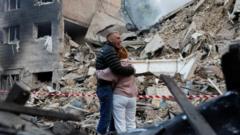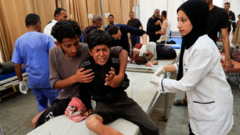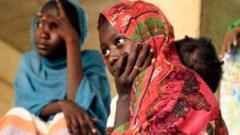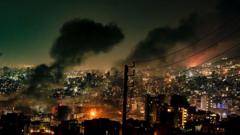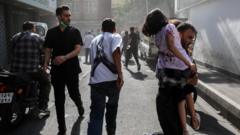The city of Mandalay faces a severe crisis following a devastating earthquake, with reports indicating widespread destruction and insufficient aid for survivors. Many remain trapped under collapsed buildings, and local residents are grappling with loss and an overwhelming absence of support as rescue operations struggle to keep pace with the disaster's aftermath.
Mandalay Devastation: Survivors Left to Struggle Post-Earthquake
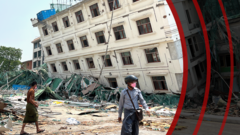
Mandalay Devastation: Survivors Left to Struggle Post-Earthquake
BBC reporters uncover the harrowing aftermath of the recent earthquake in Mandalay, revealing minimal rescue efforts and overwhelming despair among survivors.
As we drive into Mandalay, the sheer scale of destruction caused by last Friday's earthquake becomes increasingly apparent. In every direction, we see buildings reduced to rubble, with nearly every structure bearing visible cracks or signs of damage, making them unsafe for entry. The city's main hospital has resorted to treating patients outdoors as space becomes a critical issue.
The military government of Myanmar has restricted foreign journalists, forcing us to proceed undercover amid an atmosphere laden with informants and surveillance. What we encounter is a population in dire need, struggling without adequate assistance in the wake of this tragedy.
Among those desperately waiting for news is Nan Sin Hein, whose son, Sai Han Pha, remains trapped under the wreckage of a five-storey building, previously a hotel being refurbished. "If they can rescue him today, there's a chance he'll survive," she expresses, clinging to hope as rescuers are yet to arrive at the site.
Myanmar's ongoing civil unrest has significantly hindered relief efforts; security forces are overstretched with military operations against insurgents, limiting their capacity to assist in rescue operations effectively. While foreign nations have offered aid, boots on the ground predominantly originate from India, China, and Russia, leaving local volunteer efforts to fill the shortages.
Neeraj Singh, leading an Indian response team, highlights the challenges they face at the collapsed Buddhist academy, likening the destruction to a "pancake" collapse—a grim reality for those hoping to find survivors. With rising temperatures making the situation unbearable, rescuers work tirelessly, but the constant stench of decay reveals the subdued hopes of finding more victims alive.
The aftermath amplifies despair in Mandalay, where crucial landmarks like the Maha Muni Pagoda and Mandalay Palace have also suffered significant damage. As families mourn lost loved ones, the corpses are sometimes recovered not by trained authorities but by brave locals using makeshift equipment.
The government reports a death toll of 2,886, but many believe this figure is far beneath the true toll, as numerous collapsed sites remain unaddressed. Parks and streets are now shelters for those without homes, with the anxiety of aftershocks further compounding their suffering. Daw Khin Saw Myint, a 72-year-old survivor, laments her shattered reality as she tries to seek water and assistance, an image reflecting the broader struggles faced by thousands in the community.
As makeshift medical facilities spring up amid the chaos, the existing health infrastructure is also buckling under the weight of casualties. Relatives step in to care for the injured due to a lack of medical personnel—an increasingly overwhelming scene that reflects the desperate situation.
As the days proceed and the likelihood of survival diminishes, families like Nan Sin Hein’s brace for the heartbreaking possibility of loss, leaving their communities to reflect on the depths of their grief and resilience in the face of disaster.
The military government of Myanmar has restricted foreign journalists, forcing us to proceed undercover amid an atmosphere laden with informants and surveillance. What we encounter is a population in dire need, struggling without adequate assistance in the wake of this tragedy.
Among those desperately waiting for news is Nan Sin Hein, whose son, Sai Han Pha, remains trapped under the wreckage of a five-storey building, previously a hotel being refurbished. "If they can rescue him today, there's a chance he'll survive," she expresses, clinging to hope as rescuers are yet to arrive at the site.
Myanmar's ongoing civil unrest has significantly hindered relief efforts; security forces are overstretched with military operations against insurgents, limiting their capacity to assist in rescue operations effectively. While foreign nations have offered aid, boots on the ground predominantly originate from India, China, and Russia, leaving local volunteer efforts to fill the shortages.
Neeraj Singh, leading an Indian response team, highlights the challenges they face at the collapsed Buddhist academy, likening the destruction to a "pancake" collapse—a grim reality for those hoping to find survivors. With rising temperatures making the situation unbearable, rescuers work tirelessly, but the constant stench of decay reveals the subdued hopes of finding more victims alive.
The aftermath amplifies despair in Mandalay, where crucial landmarks like the Maha Muni Pagoda and Mandalay Palace have also suffered significant damage. As families mourn lost loved ones, the corpses are sometimes recovered not by trained authorities but by brave locals using makeshift equipment.
The government reports a death toll of 2,886, but many believe this figure is far beneath the true toll, as numerous collapsed sites remain unaddressed. Parks and streets are now shelters for those without homes, with the anxiety of aftershocks further compounding their suffering. Daw Khin Saw Myint, a 72-year-old survivor, laments her shattered reality as she tries to seek water and assistance, an image reflecting the broader struggles faced by thousands in the community.
As makeshift medical facilities spring up amid the chaos, the existing health infrastructure is also buckling under the weight of casualties. Relatives step in to care for the injured due to a lack of medical personnel—an increasingly overwhelming scene that reflects the desperate situation.
As the days proceed and the likelihood of survival diminishes, families like Nan Sin Hein’s brace for the heartbreaking possibility of loss, leaving their communities to reflect on the depths of their grief and resilience in the face of disaster.

